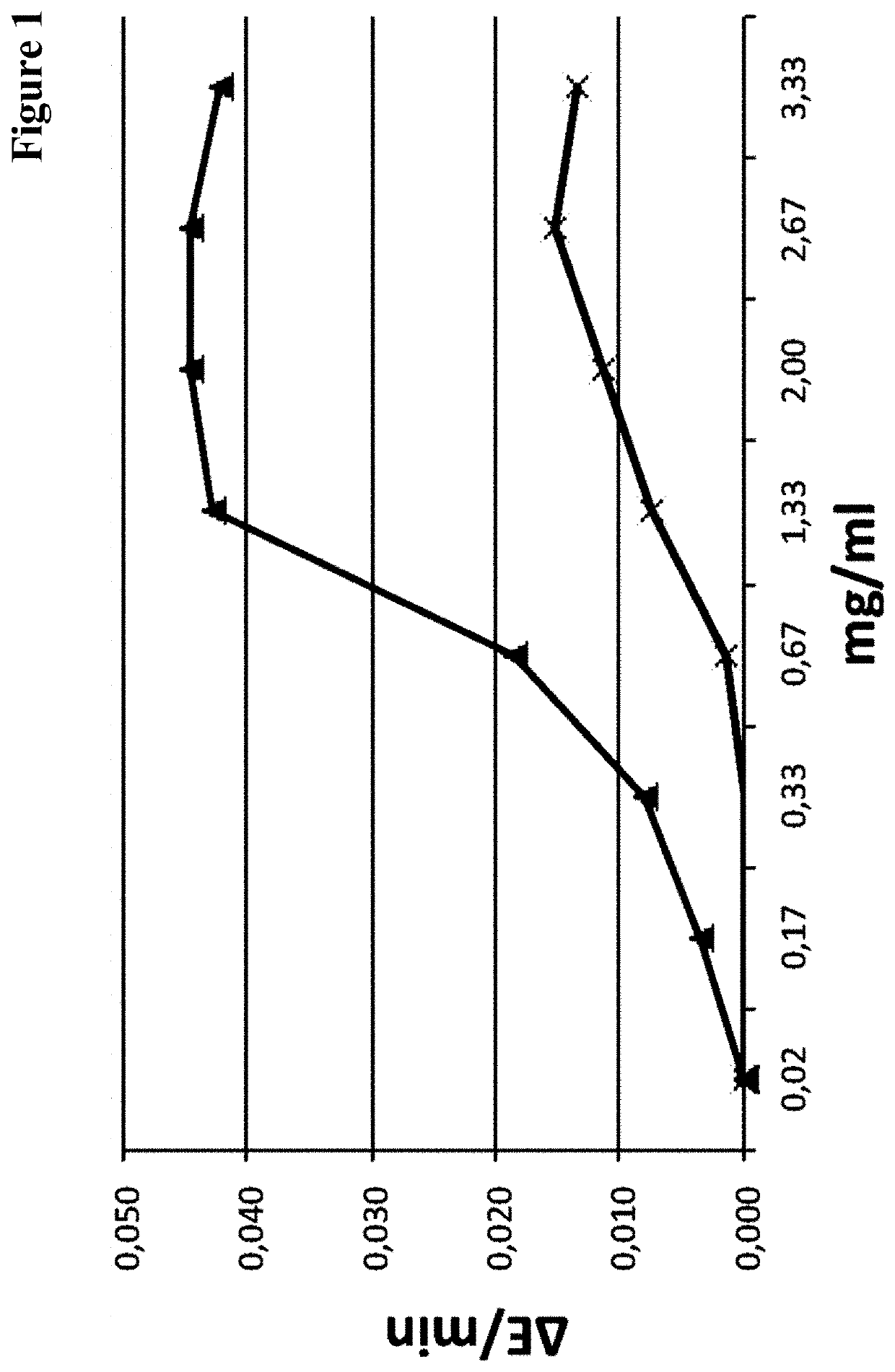Soluble Sortase A
a sortase and soluble technology, applied in the field of soluble sortase, can solve the problems of limited application of sortases for technical bioconjugation, and achieve the effect of increasing enzymatic activity
- Summary
- Abstract
- Description
- Claims
- Application Information
AI Technical Summary
Benefits of technology
Problems solved by technology
Method used
Image
Examples
example 1
Generation of an Expression Plasmid for Soluble Sortase A Staphylococcus aureus derived Sortase A The sortase gene encodes an N-terminally truncated Staphylococcus aureus sortase A (60-206) molecule (amino acid sequence of SEQ ID NO: 05).
[0215]The expression plasmid for the expression of soluble sortase in E. coli cells comprised besides the soluble sortase expression cassette an origin of replication from the vector pUC18, which allows replication of this plasmid in E. coli, and the URA3 gene as selectable marker, and the LacI gene to allow induction of transcription using IPTG.
[0216]The transcription unit of the soluble sortase comprised the following functional elements:[0217]a T5 promoter,[0218]a purification tag,[0219]an N-terminally truncated S. aureus sortase A encoding nucleic acid, and[0220]the To and fd termination sequences.
[0221]The expression plasmid for the transient expression of soluble sortase in HEK293 cells comprised besides the soluble sortase expression cassette...
example 2
Transient Expression and Analytical Characterization
E. coli:
[0276]The recombinant production of Sortase was performed by growing E. coli cells transformed with the respective Sortase expression plasmids to an OD578 of approx. 0.9 at 37° C. (pre-culture). At this OD578 of approx. 0.9 protein expression was induced by adding 2 mM IPTG and growing the cells for an additional 24 hours at 28° C. Thereafter, cells were harvested by centrifugation and lysed via high pressure using a homogenizer. Cell lysates were centrifuged to remove cell debris and subsequently the cell lysates were stored at reduced temperature (e.g. −80° C.) until purification. Soluble Sortase was purified using Ni-NTA chromatography followed by size exclusion chromatography. For depletion of endotoxins an anion exchange chromatography was performed in flow through mode. The protein concentration of sortase preparations was determined by measuring the optical density (OD) at 280 nm, using the molar extinction coeffici...
example 3
Activity Assay
[0282]Forty microliters of each variant were mixed with 80 μl substrate solution (50 mM Tris pH 7.5, 200 mM NaCl, 10 mM CaCl2, 30 μM of a glucose dehydrogenase (containing one of the substrates of the Sortase reaction (LPXTG)) and biotin (containing the other substrate of the Sortase reaction, GGGG)). This reaction mixture was incubated at 37° C. for 2 hours. Thereafter the reaction mixture was centrifuged for 10 min at 5000×g. The supernatant (50 μL) was added to 100 μL of 50 mM Tris buffer (pH 7.5) comprising 200 mM NaCl, 10 mM CaCl2 and streptavidin coated magnetic beads. The mixture was incubated for 30 min at 30° C. at 200 rpm. Thereafter the magnetic beads were washed five times with 300 μL washing buffer each (50 mM Tris, pH 7.5, 200 mM NaCl, 10 mM CaCl2, 5 mg / mL BSA, 0.1% Triton X-100) in V-bottom micro-titer-plates using a magnet and a vacuum pump. Afterwards the beads were resuspended in 100 μL citrate buffer and 10 μL thereof are transferred to a new well. T...
PUM
| Property | Measurement | Unit |
|---|---|---|
| temperature | aaaaa | aaaaa |
| temperature | aaaaa | aaaaa |
| temperature | aaaaa | aaaaa |
Abstract
Description
Claims
Application Information
 Login to View More
Login to View More - R&D
- Intellectual Property
- Life Sciences
- Materials
- Tech Scout
- Unparalleled Data Quality
- Higher Quality Content
- 60% Fewer Hallucinations
Browse by: Latest US Patents, China's latest patents, Technical Efficacy Thesaurus, Application Domain, Technology Topic, Popular Technical Reports.
© 2025 PatSnap. All rights reserved.Legal|Privacy policy|Modern Slavery Act Transparency Statement|Sitemap|About US| Contact US: help@patsnap.com



